Business Strategy Analysis of Lloyds Bank - University Report
VerifiedAdded on 2022/08/22
|21
|4266
|12
Report
AI Summary
This report provides a comprehensive business strategy analysis of Lloyds Bank, a major player in the UK banking sector. The analysis begins with an introduction to Lloyds Bank, its history, and its current strategic direction, focusing on its transformation strategy for success in a digital world. The report applies various frameworks to assess the macro-environment, including stakeholder analysis and a detailed PESTEL analysis, considering political, economic, social, technological, legal, and environmental factors. The internal capabilities of Lloyds Bank are examined, including its strengths, weaknesses, and strategic vision. Porter's Five Forces model is then applied to evaluate the competitive forces within the financial sector. The report concludes with the development of strategic plans for Lloyds Bank, proposing tangible and tactical strategic priorities and objectives to improve its competitive edge and market position, based on the outcomes of the analysis. The report highlights the importance of digital transformation, customer experience, and stakeholder engagement in Lloyds Bank's strategic approach. The report is a detailed study of Lloyds Bank's business strategy, providing a framework for understanding the bank's operations and its position in the financial industry.
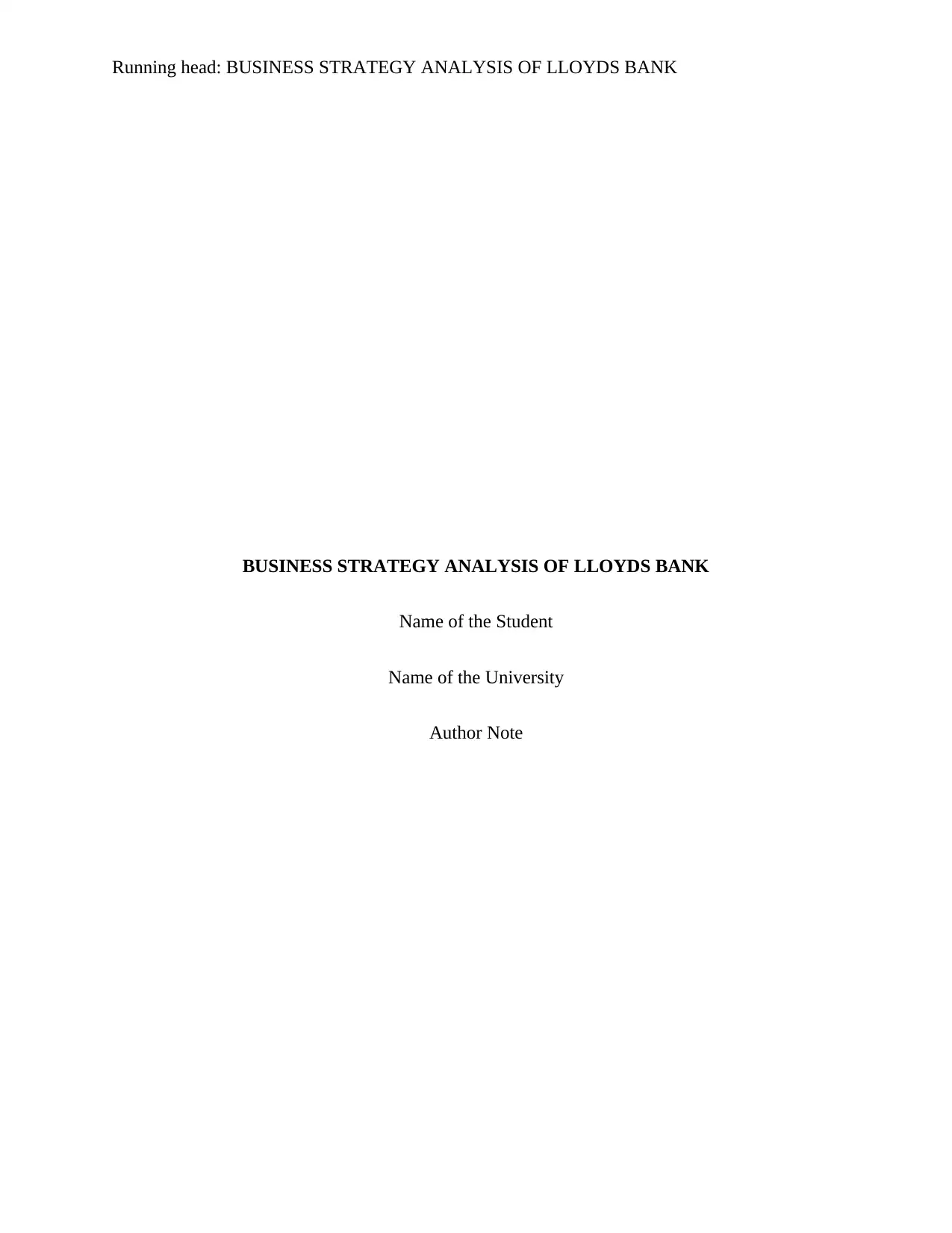
Running head: BUSINESS STRATEGY ANALYSIS OF LLOYDS BANK
BUSINESS STRATEGY ANALYSIS OF LLOYDS BANK
Name of the Student
Name of the University
Author Note
BUSINESS STRATEGY ANALYSIS OF LLOYDS BANK
Name of the Student
Name of the University
Author Note
Paraphrase This Document
Need a fresh take? Get an instant paraphrase of this document with our AI Paraphraser
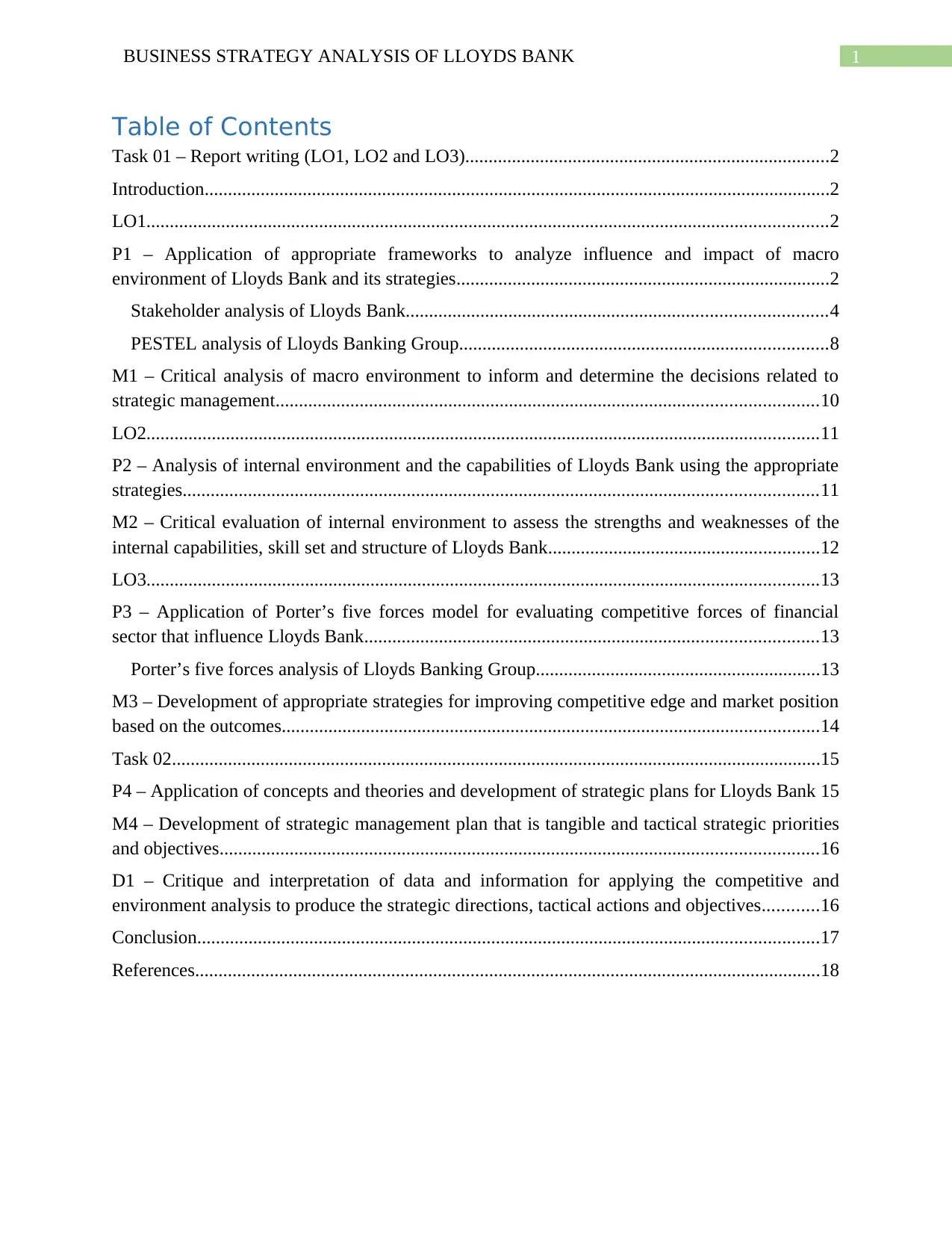
1BUSINESS STRATEGY ANALYSIS OF LLOYDS BANK
Table of Contents
Task 01 – Report writing (LO1, LO2 and LO3)..............................................................................2
Introduction......................................................................................................................................2
LO1..................................................................................................................................................2
P1 – Application of appropriate frameworks to analyze influence and impact of macro
environment of Lloyds Bank and its strategies................................................................................2
Stakeholder analysis of Lloyds Bank..........................................................................................4
PESTEL analysis of Lloyds Banking Group...............................................................................8
M1 – Critical analysis of macro environment to inform and determine the decisions related to
strategic management....................................................................................................................10
LO2................................................................................................................................................11
P2 – Analysis of internal environment and the capabilities of Lloyds Bank using the appropriate
strategies........................................................................................................................................11
M2 – Critical evaluation of internal environment to assess the strengths and weaknesses of the
internal capabilities, skill set and structure of Lloyds Bank..........................................................12
LO3................................................................................................................................................13
P3 – Application of Porter’s five forces model for evaluating competitive forces of financial
sector that influence Lloyds Bank.................................................................................................13
Porter’s five forces analysis of Lloyds Banking Group.............................................................13
M3 – Development of appropriate strategies for improving competitive edge and market position
based on the outcomes...................................................................................................................14
Task 02...........................................................................................................................................15
P4 – Application of concepts and theories and development of strategic plans for Lloyds Bank 15
M4 – Development of strategic management plan that is tangible and tactical strategic priorities
and objectives................................................................................................................................16
D1 – Critique and interpretation of data and information for applying the competitive and
environment analysis to produce the strategic directions, tactical actions and objectives............16
Conclusion.....................................................................................................................................17
References......................................................................................................................................18
Table of Contents
Task 01 – Report writing (LO1, LO2 and LO3)..............................................................................2
Introduction......................................................................................................................................2
LO1..................................................................................................................................................2
P1 – Application of appropriate frameworks to analyze influence and impact of macro
environment of Lloyds Bank and its strategies................................................................................2
Stakeholder analysis of Lloyds Bank..........................................................................................4
PESTEL analysis of Lloyds Banking Group...............................................................................8
M1 – Critical analysis of macro environment to inform and determine the decisions related to
strategic management....................................................................................................................10
LO2................................................................................................................................................11
P2 – Analysis of internal environment and the capabilities of Lloyds Bank using the appropriate
strategies........................................................................................................................................11
M2 – Critical evaluation of internal environment to assess the strengths and weaknesses of the
internal capabilities, skill set and structure of Lloyds Bank..........................................................12
LO3................................................................................................................................................13
P3 – Application of Porter’s five forces model for evaluating competitive forces of financial
sector that influence Lloyds Bank.................................................................................................13
Porter’s five forces analysis of Lloyds Banking Group.............................................................13
M3 – Development of appropriate strategies for improving competitive edge and market position
based on the outcomes...................................................................................................................14
Task 02...........................................................................................................................................15
P4 – Application of concepts and theories and development of strategic plans for Lloyds Bank 15
M4 – Development of strategic management plan that is tangible and tactical strategic priorities
and objectives................................................................................................................................16
D1 – Critique and interpretation of data and information for applying the competitive and
environment analysis to produce the strategic directions, tactical actions and objectives............16
Conclusion.....................................................................................................................................17
References......................................................................................................................................18
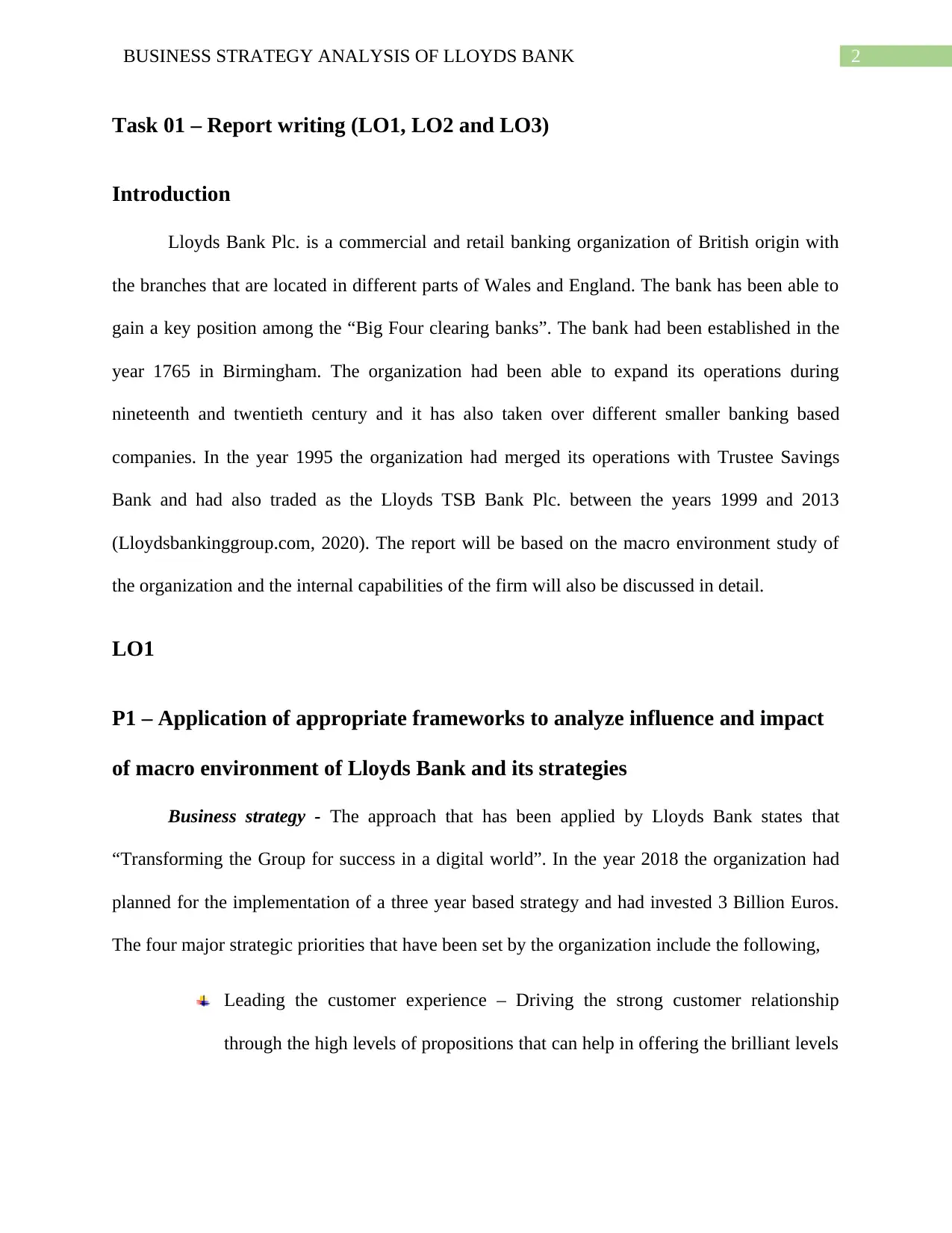
2BUSINESS STRATEGY ANALYSIS OF LLOYDS BANK
Task 01 – Report writing (LO1, LO2 and LO3)
Introduction
Lloyds Bank Plc. is a commercial and retail banking organization of British origin with
the branches that are located in different parts of Wales and England. The bank has been able to
gain a key position among the “Big Four clearing banks”. The bank had been established in the
year 1765 in Birmingham. The organization had been able to expand its operations during
nineteenth and twentieth century and it has also taken over different smaller banking based
companies. In the year 1995 the organization had merged its operations with Trustee Savings
Bank and had also traded as the Lloyds TSB Bank Plc. between the years 1999 and 2013
(Lloydsbankinggroup.com, 2020). The report will be based on the macro environment study of
the organization and the internal capabilities of the firm will also be discussed in detail.
LO1
P1 – Application of appropriate frameworks to analyze influence and impact
of macro environment of Lloyds Bank and its strategies
Business strategy - The approach that has been applied by Lloyds Bank states that
“Transforming the Group for success in a digital world”. In the year 2018 the organization had
planned for the implementation of a three year based strategy and had invested 3 Billion Euros.
The four major strategic priorities that have been set by the organization include the following,
Leading the customer experience – Driving the strong customer relationship
through the high levels of propositions that can help in offering the brilliant levels
Task 01 – Report writing (LO1, LO2 and LO3)
Introduction
Lloyds Bank Plc. is a commercial and retail banking organization of British origin with
the branches that are located in different parts of Wales and England. The bank has been able to
gain a key position among the “Big Four clearing banks”. The bank had been established in the
year 1765 in Birmingham. The organization had been able to expand its operations during
nineteenth and twentieth century and it has also taken over different smaller banking based
companies. In the year 1995 the organization had merged its operations with Trustee Savings
Bank and had also traded as the Lloyds TSB Bank Plc. between the years 1999 and 2013
(Lloydsbankinggroup.com, 2020). The report will be based on the macro environment study of
the organization and the internal capabilities of the firm will also be discussed in detail.
LO1
P1 – Application of appropriate frameworks to analyze influence and impact
of macro environment of Lloyds Bank and its strategies
Business strategy - The approach that has been applied by Lloyds Bank states that
“Transforming the Group for success in a digital world”. In the year 2018 the organization had
planned for the implementation of a three year based strategy and had invested 3 Billion Euros.
The four major strategic priorities that have been set by the organization include the following,
Leading the customer experience – Driving the strong customer relationship
through the high levels of propositions that can help in offering the brilliant levels
⊘ This is a preview!⊘
Do you want full access?
Subscribe today to unlock all pages.

Trusted by 1+ million students worldwide
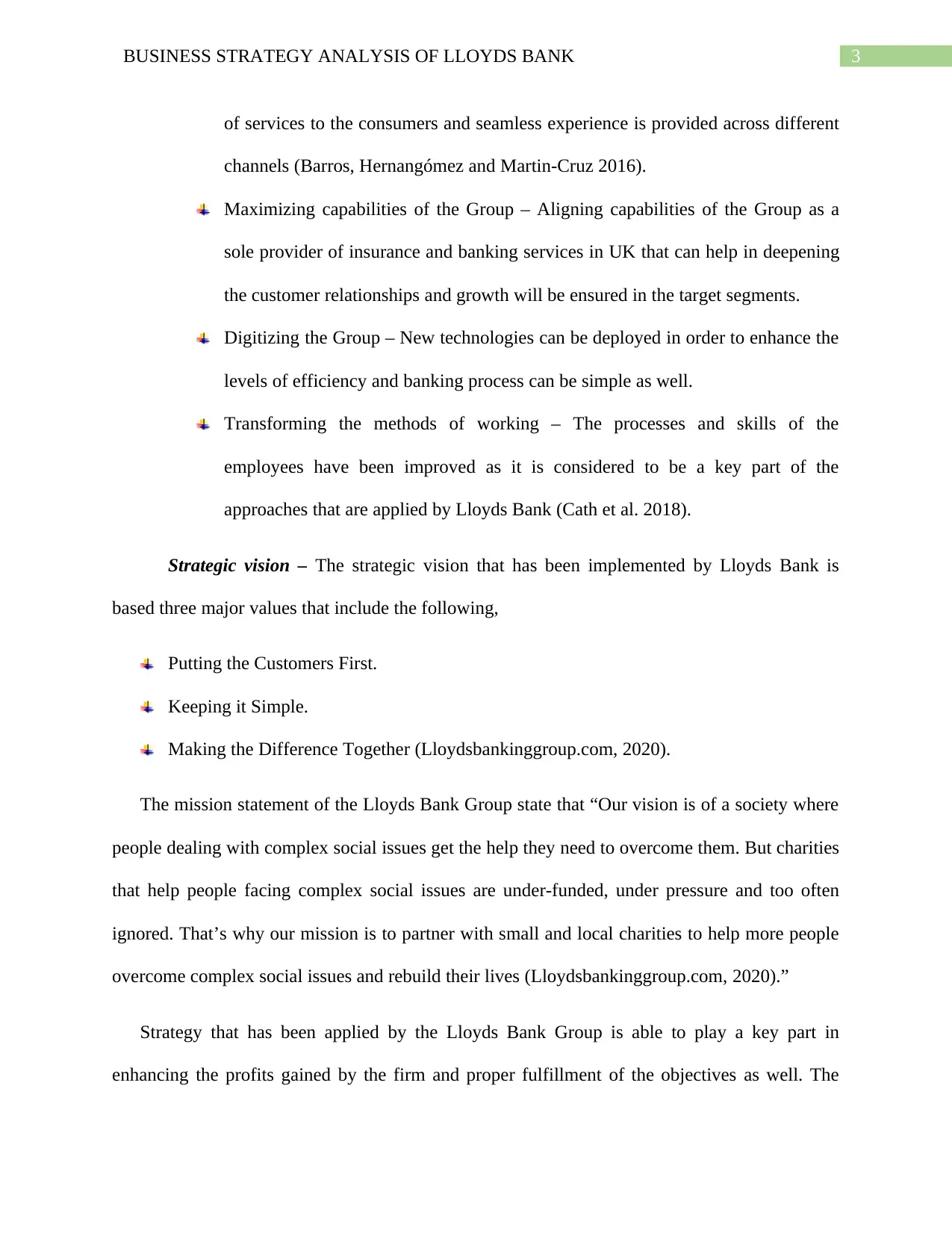
3BUSINESS STRATEGY ANALYSIS OF LLOYDS BANK
of services to the consumers and seamless experience is provided across different
channels (Barros, Hernangómez and Martin-Cruz 2016).
Maximizing capabilities of the Group – Aligning capabilities of the Group as a
sole provider of insurance and banking services in UK that can help in deepening
the customer relationships and growth will be ensured in the target segments.
Digitizing the Group – New technologies can be deployed in order to enhance the
levels of efficiency and banking process can be simple as well.
Transforming the methods of working – The processes and skills of the
employees have been improved as it is considered to be a key part of the
approaches that are applied by Lloyds Bank (Cath et al. 2018).
Strategic vision – The strategic vision that has been implemented by Lloyds Bank is
based three major values that include the following,
Putting the Customers First.
Keeping it Simple.
Making the Difference Together (Lloydsbankinggroup.com, 2020).
The mission statement of the Lloyds Bank Group state that “Our vision is of a society where
people dealing with complex social issues get the help they need to overcome them. But charities
that help people facing complex social issues are under-funded, under pressure and too often
ignored. That’s why our mission is to partner with small and local charities to help more people
overcome complex social issues and rebuild their lives (Lloydsbankinggroup.com, 2020).”
Strategy that has been applied by the Lloyds Bank Group is able to play a key part in
enhancing the profits gained by the firm and proper fulfillment of the objectives as well. The
of services to the consumers and seamless experience is provided across different
channels (Barros, Hernangómez and Martin-Cruz 2016).
Maximizing capabilities of the Group – Aligning capabilities of the Group as a
sole provider of insurance and banking services in UK that can help in deepening
the customer relationships and growth will be ensured in the target segments.
Digitizing the Group – New technologies can be deployed in order to enhance the
levels of efficiency and banking process can be simple as well.
Transforming the methods of working – The processes and skills of the
employees have been improved as it is considered to be a key part of the
approaches that are applied by Lloyds Bank (Cath et al. 2018).
Strategic vision – The strategic vision that has been implemented by Lloyds Bank is
based three major values that include the following,
Putting the Customers First.
Keeping it Simple.
Making the Difference Together (Lloydsbankinggroup.com, 2020).
The mission statement of the Lloyds Bank Group state that “Our vision is of a society where
people dealing with complex social issues get the help they need to overcome them. But charities
that help people facing complex social issues are under-funded, under pressure and too often
ignored. That’s why our mission is to partner with small and local charities to help more people
overcome complex social issues and rebuild their lives (Lloydsbankinggroup.com, 2020).”
Strategy that has been applied by the Lloyds Bank Group is able to play a key part in
enhancing the profits gained by the firm and proper fulfillment of the objectives as well. The
Paraphrase This Document
Need a fresh take? Get an instant paraphrase of this document with our AI Paraphraser
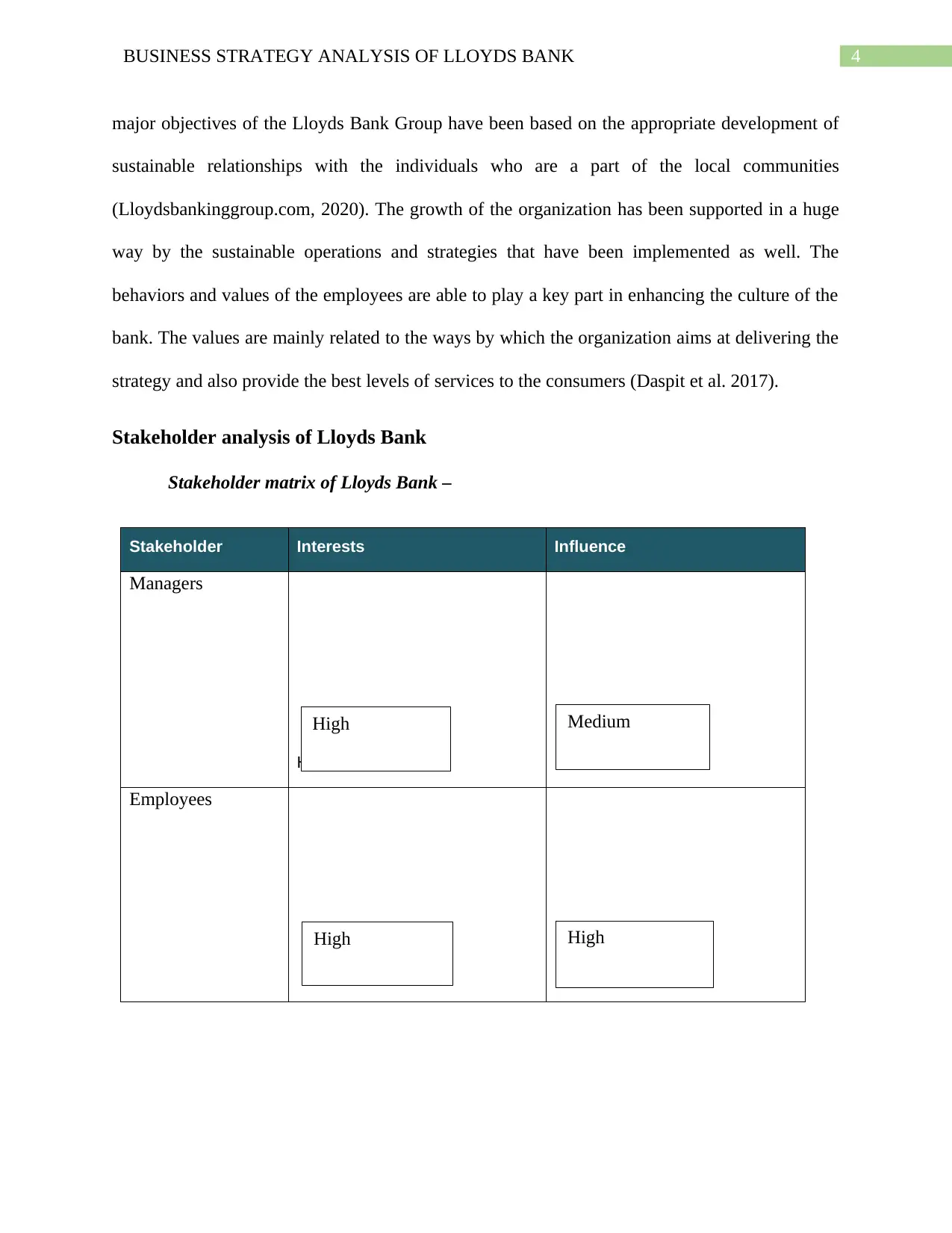
4BUSINESS STRATEGY ANALYSIS OF LLOYDS BANK
major objectives of the Lloyds Bank Group have been based on the appropriate development of
sustainable relationships with the individuals who are a part of the local communities
(Lloydsbankinggroup.com, 2020). The growth of the organization has been supported in a huge
way by the sustainable operations and strategies that have been implemented as well. The
behaviors and values of the employees are able to play a key part in enhancing the culture of the
bank. The values are mainly related to the ways by which the organization aims at delivering the
strategy and also provide the best levels of services to the consumers (Daspit et al. 2017).
Stakeholder analysis of Lloyds Bank
Stakeholder matrix of Lloyds Bank –
Stakeholder Interests Influence
Managers
Hifgh
Employees
High Medium
High High
major objectives of the Lloyds Bank Group have been based on the appropriate development of
sustainable relationships with the individuals who are a part of the local communities
(Lloydsbankinggroup.com, 2020). The growth of the organization has been supported in a huge
way by the sustainable operations and strategies that have been implemented as well. The
behaviors and values of the employees are able to play a key part in enhancing the culture of the
bank. The values are mainly related to the ways by which the organization aims at delivering the
strategy and also provide the best levels of services to the consumers (Daspit et al. 2017).
Stakeholder analysis of Lloyds Bank
Stakeholder matrix of Lloyds Bank –
Stakeholder Interests Influence
Managers
Hifgh
Employees
High Medium
High High
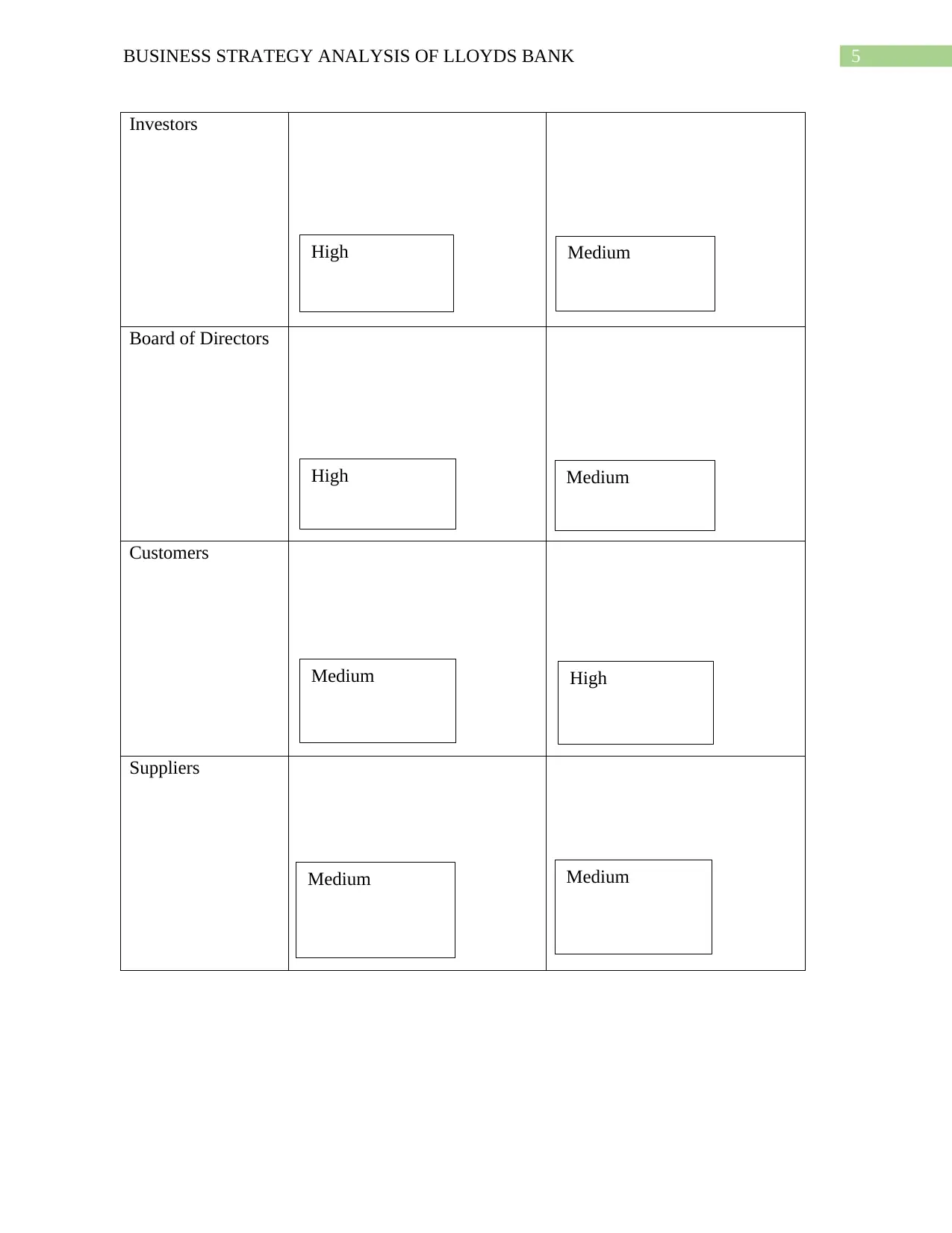
5BUSINESS STRATEGY ANALYSIS OF LLOYDS BANK
Investors
Board of Directors
Customers
Suppliers
High Medium
High Medium
Medium High
Medium Medium
Investors
Board of Directors
Customers
Suppliers
High Medium
High Medium
Medium High
Medium Medium
⊘ This is a preview!⊘
Do you want full access?
Subscribe today to unlock all pages.

Trusted by 1+ million students worldwide
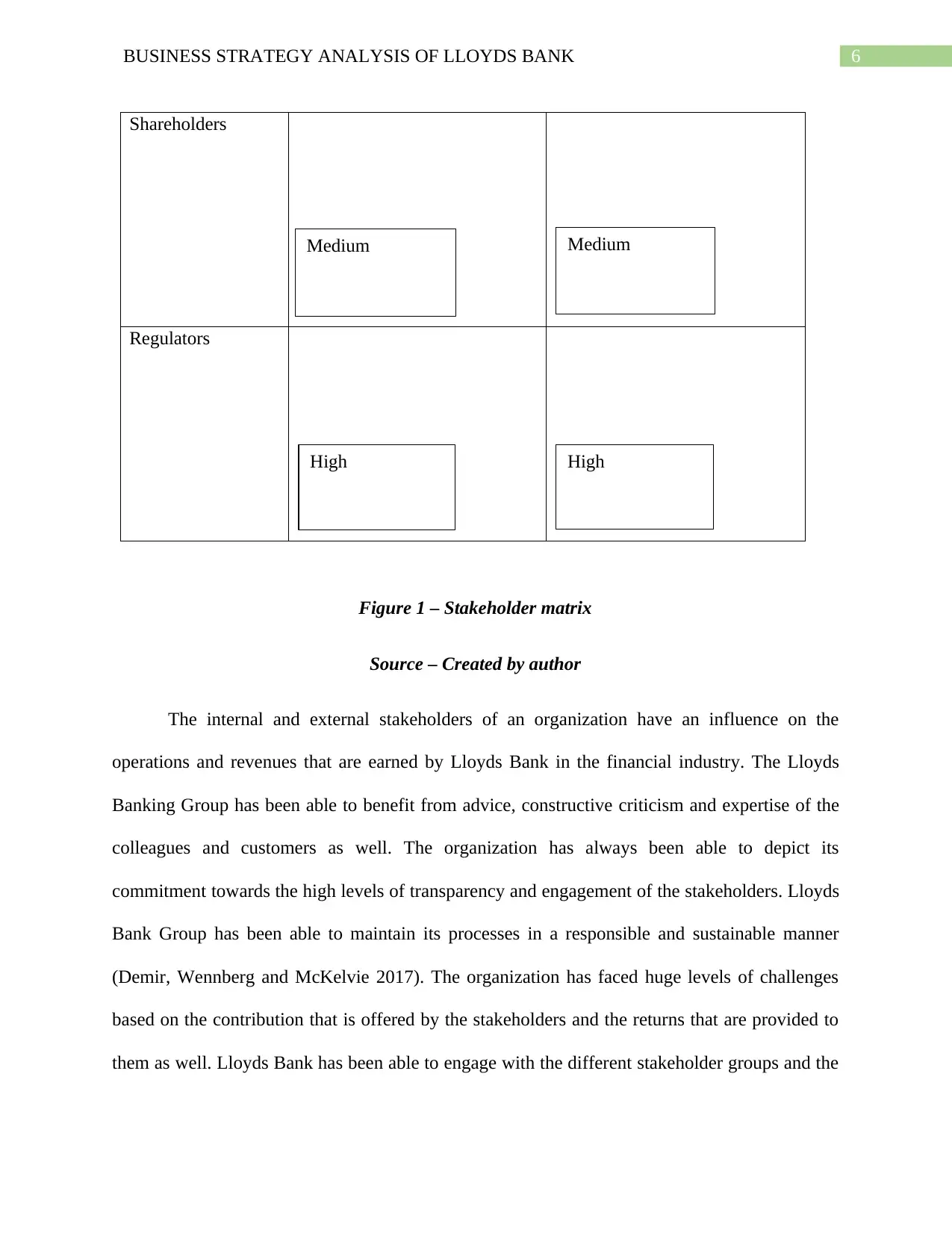
6BUSINESS STRATEGY ANALYSIS OF LLOYDS BANK
Shareholders
Regulators
Figure 1 – Stakeholder matrix
Source – Created by author
The internal and external stakeholders of an organization have an influence on the
operations and revenues that are earned by Lloyds Bank in the financial industry. The Lloyds
Banking Group has been able to benefit from advice, constructive criticism and expertise of the
colleagues and customers as well. The organization has always been able to depict its
commitment towards the high levels of transparency and engagement of the stakeholders. Lloyds
Bank Group has been able to maintain its processes in a responsible and sustainable manner
(Demir, Wennberg and McKelvie 2017). The organization has faced huge levels of challenges
based on the contribution that is offered by the stakeholders and the returns that are provided to
them as well. Lloyds Bank has been able to engage with the different stakeholder groups and the
Medium Medium
High High
Shareholders
Regulators
Figure 1 – Stakeholder matrix
Source – Created by author
The internal and external stakeholders of an organization have an influence on the
operations and revenues that are earned by Lloyds Bank in the financial industry. The Lloyds
Banking Group has been able to benefit from advice, constructive criticism and expertise of the
colleagues and customers as well. The organization has always been able to depict its
commitment towards the high levels of transparency and engagement of the stakeholders. Lloyds
Bank Group has been able to maintain its processes in a responsible and sustainable manner
(Demir, Wennberg and McKelvie 2017). The organization has faced huge levels of challenges
based on the contribution that is offered by the stakeholders and the returns that are provided to
them as well. Lloyds Bank has been able to engage with the different stakeholder groups and the
Medium Medium
High High
Paraphrase This Document
Need a fresh take? Get an instant paraphrase of this document with our AI Paraphraser
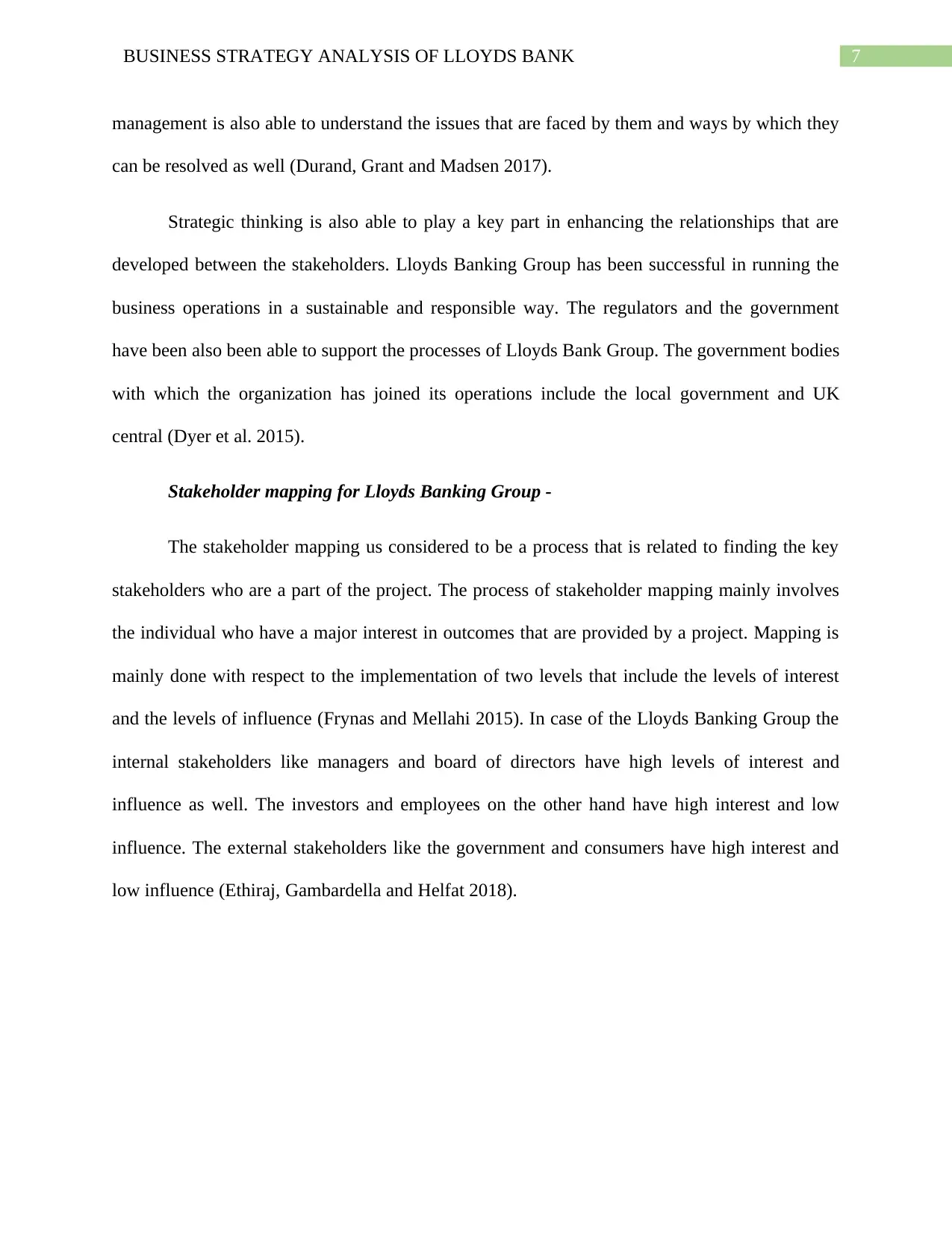
7BUSINESS STRATEGY ANALYSIS OF LLOYDS BANK
management is also able to understand the issues that are faced by them and ways by which they
can be resolved as well (Durand, Grant and Madsen 2017).
Strategic thinking is also able to play a key part in enhancing the relationships that are
developed between the stakeholders. Lloyds Banking Group has been successful in running the
business operations in a sustainable and responsible way. The regulators and the government
have been also been able to support the processes of Lloyds Bank Group. The government bodies
with which the organization has joined its operations include the local government and UK
central (Dyer et al. 2015).
Stakeholder mapping for Lloyds Banking Group -
The stakeholder mapping us considered to be a process that is related to finding the key
stakeholders who are a part of the project. The process of stakeholder mapping mainly involves
the individual who have a major interest in outcomes that are provided by a project. Mapping is
mainly done with respect to the implementation of two levels that include the levels of interest
and the levels of influence (Frynas and Mellahi 2015). In case of the Lloyds Banking Group the
internal stakeholders like managers and board of directors have high levels of interest and
influence as well. The investors and employees on the other hand have high interest and low
influence. The external stakeholders like the government and consumers have high interest and
low influence (Ethiraj, Gambardella and Helfat 2018).
management is also able to understand the issues that are faced by them and ways by which they
can be resolved as well (Durand, Grant and Madsen 2017).
Strategic thinking is also able to play a key part in enhancing the relationships that are
developed between the stakeholders. Lloyds Banking Group has been successful in running the
business operations in a sustainable and responsible way. The regulators and the government
have been also been able to support the processes of Lloyds Bank Group. The government bodies
with which the organization has joined its operations include the local government and UK
central (Dyer et al. 2015).
Stakeholder mapping for Lloyds Banking Group -
The stakeholder mapping us considered to be a process that is related to finding the key
stakeholders who are a part of the project. The process of stakeholder mapping mainly involves
the individual who have a major interest in outcomes that are provided by a project. Mapping is
mainly done with respect to the implementation of two levels that include the levels of interest
and the levels of influence (Frynas and Mellahi 2015). In case of the Lloyds Banking Group the
internal stakeholders like managers and board of directors have high levels of interest and
influence as well. The investors and employees on the other hand have high interest and low
influence. The external stakeholders like the government and consumers have high interest and
low influence (Ethiraj, Gambardella and Helfat 2018).
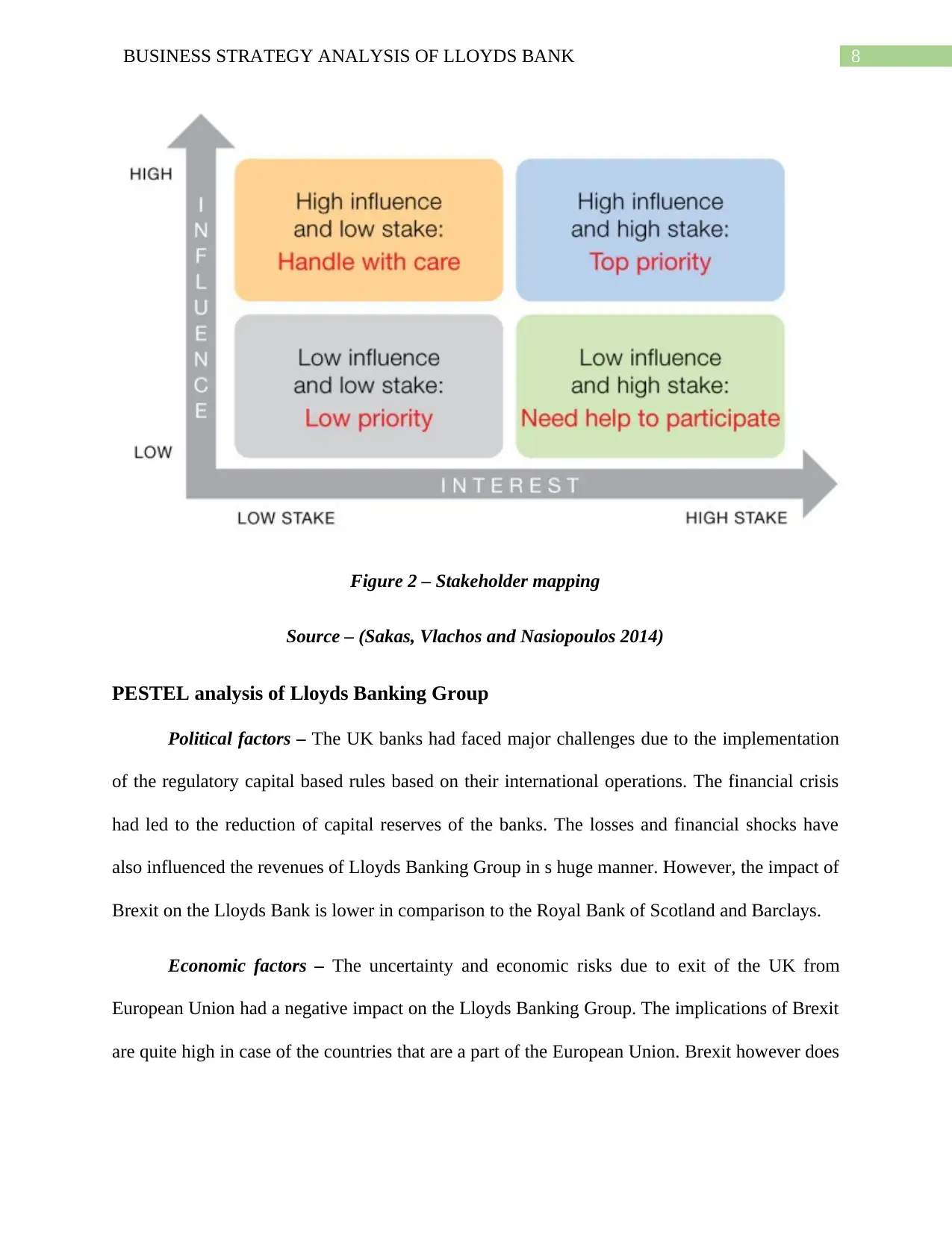
8BUSINESS STRATEGY ANALYSIS OF LLOYDS BANK
Figure 2 – Stakeholder mapping
Source – (Sakas, Vlachos and Nasiopoulos 2014)
PESTEL analysis of Lloyds Banking Group
Political factors – The UK banks had faced major challenges due to the implementation
of the regulatory capital based rules based on their international operations. The financial crisis
had led to the reduction of capital reserves of the banks. The losses and financial shocks have
also influenced the revenues of Lloyds Banking Group in s huge manner. However, the impact of
Brexit on the Lloyds Bank is lower in comparison to the Royal Bank of Scotland and Barclays.
Economic factors – The uncertainty and economic risks due to exit of the UK from
European Union had a negative impact on the Lloyds Banking Group. The implications of Brexit
are quite high in case of the countries that are a part of the European Union. Brexit however does
Figure 2 – Stakeholder mapping
Source – (Sakas, Vlachos and Nasiopoulos 2014)
PESTEL analysis of Lloyds Banking Group
Political factors – The UK banks had faced major challenges due to the implementation
of the regulatory capital based rules based on their international operations. The financial crisis
had led to the reduction of capital reserves of the banks. The losses and financial shocks have
also influenced the revenues of Lloyds Banking Group in s huge manner. However, the impact of
Brexit on the Lloyds Bank is lower in comparison to the Royal Bank of Scotland and Barclays.
Economic factors – The uncertainty and economic risks due to exit of the UK from
European Union had a negative impact on the Lloyds Banking Group. The implications of Brexit
are quite high in case of the countries that are a part of the European Union. Brexit however does
⊘ This is a preview!⊘
Do you want full access?
Subscribe today to unlock all pages.

Trusted by 1+ million students worldwide
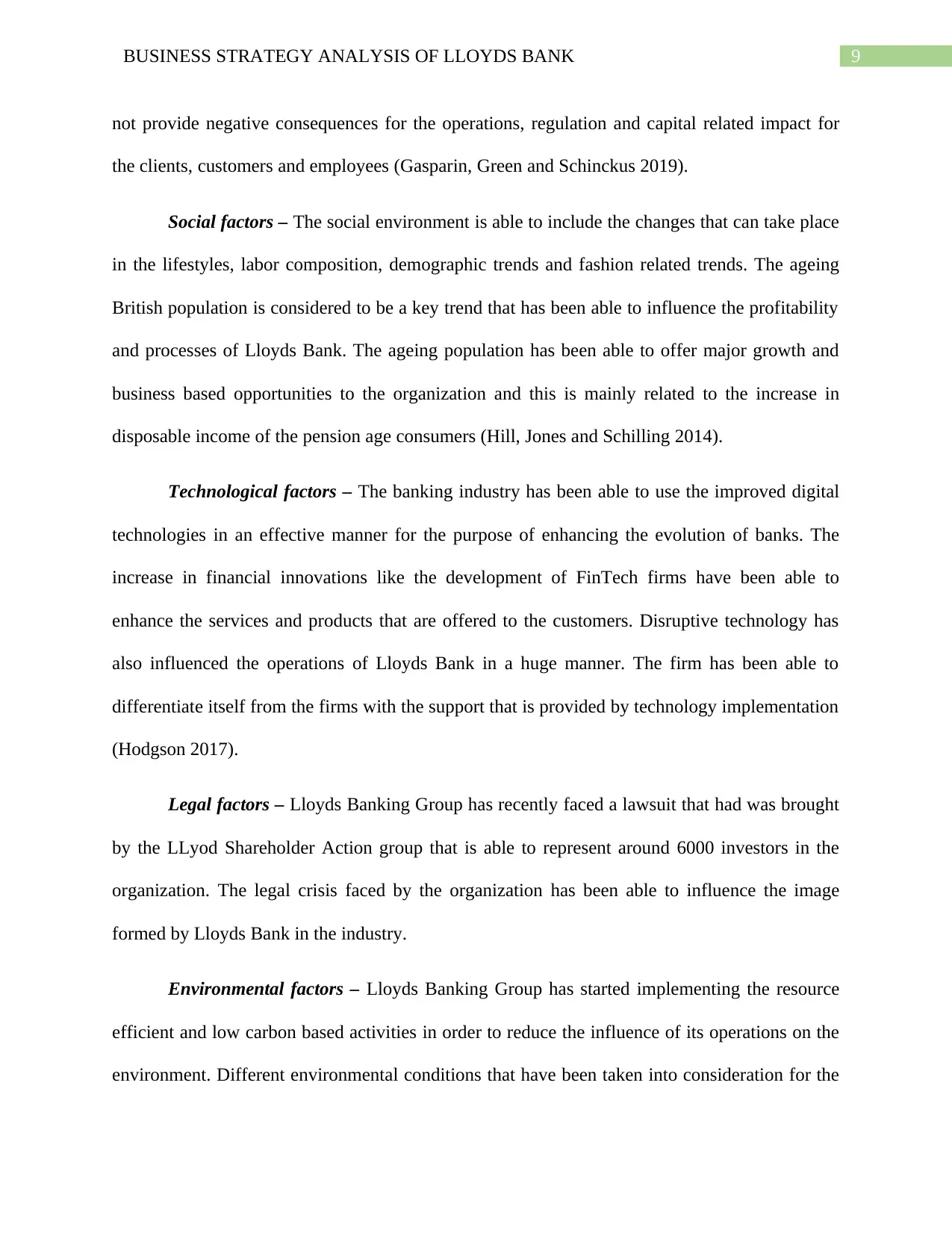
9BUSINESS STRATEGY ANALYSIS OF LLOYDS BANK
not provide negative consequences for the operations, regulation and capital related impact for
the clients, customers and employees (Gasparin, Green and Schinckus 2019).
Social factors – The social environment is able to include the changes that can take place
in the lifestyles, labor composition, demographic trends and fashion related trends. The ageing
British population is considered to be a key trend that has been able to influence the profitability
and processes of Lloyds Bank. The ageing population has been able to offer major growth and
business based opportunities to the organization and this is mainly related to the increase in
disposable income of the pension age consumers (Hill, Jones and Schilling 2014).
Technological factors – The banking industry has been able to use the improved digital
technologies in an effective manner for the purpose of enhancing the evolution of banks. The
increase in financial innovations like the development of FinTech firms have been able to
enhance the services and products that are offered to the customers. Disruptive technology has
also influenced the operations of Lloyds Bank in a huge manner. The firm has been able to
differentiate itself from the firms with the support that is provided by technology implementation
(Hodgson 2017).
Legal factors – Lloyds Banking Group has recently faced a lawsuit that had was brought
by the LLyod Shareholder Action group that is able to represent around 6000 investors in the
organization. The legal crisis faced by the organization has been able to influence the image
formed by Lloyds Bank in the industry.
Environmental factors – Lloyds Banking Group has started implementing the resource
efficient and low carbon based activities in order to reduce the influence of its operations on the
environment. Different environmental conditions that have been taken into consideration for the
not provide negative consequences for the operations, regulation and capital related impact for
the clients, customers and employees (Gasparin, Green and Schinckus 2019).
Social factors – The social environment is able to include the changes that can take place
in the lifestyles, labor composition, demographic trends and fashion related trends. The ageing
British population is considered to be a key trend that has been able to influence the profitability
and processes of Lloyds Bank. The ageing population has been able to offer major growth and
business based opportunities to the organization and this is mainly related to the increase in
disposable income of the pension age consumers (Hill, Jones and Schilling 2014).
Technological factors – The banking industry has been able to use the improved digital
technologies in an effective manner for the purpose of enhancing the evolution of banks. The
increase in financial innovations like the development of FinTech firms have been able to
enhance the services and products that are offered to the customers. Disruptive technology has
also influenced the operations of Lloyds Bank in a huge manner. The firm has been able to
differentiate itself from the firms with the support that is provided by technology implementation
(Hodgson 2017).
Legal factors – Lloyds Banking Group has recently faced a lawsuit that had was brought
by the LLyod Shareholder Action group that is able to represent around 6000 investors in the
organization. The legal crisis faced by the organization has been able to influence the image
formed by Lloyds Bank in the industry.
Environmental factors – Lloyds Banking Group has started implementing the resource
efficient and low carbon based activities in order to reduce the influence of its operations on the
environment. Different environmental conditions that have been taken into consideration for the
Paraphrase This Document
Need a fresh take? Get an instant paraphrase of this document with our AI Paraphraser
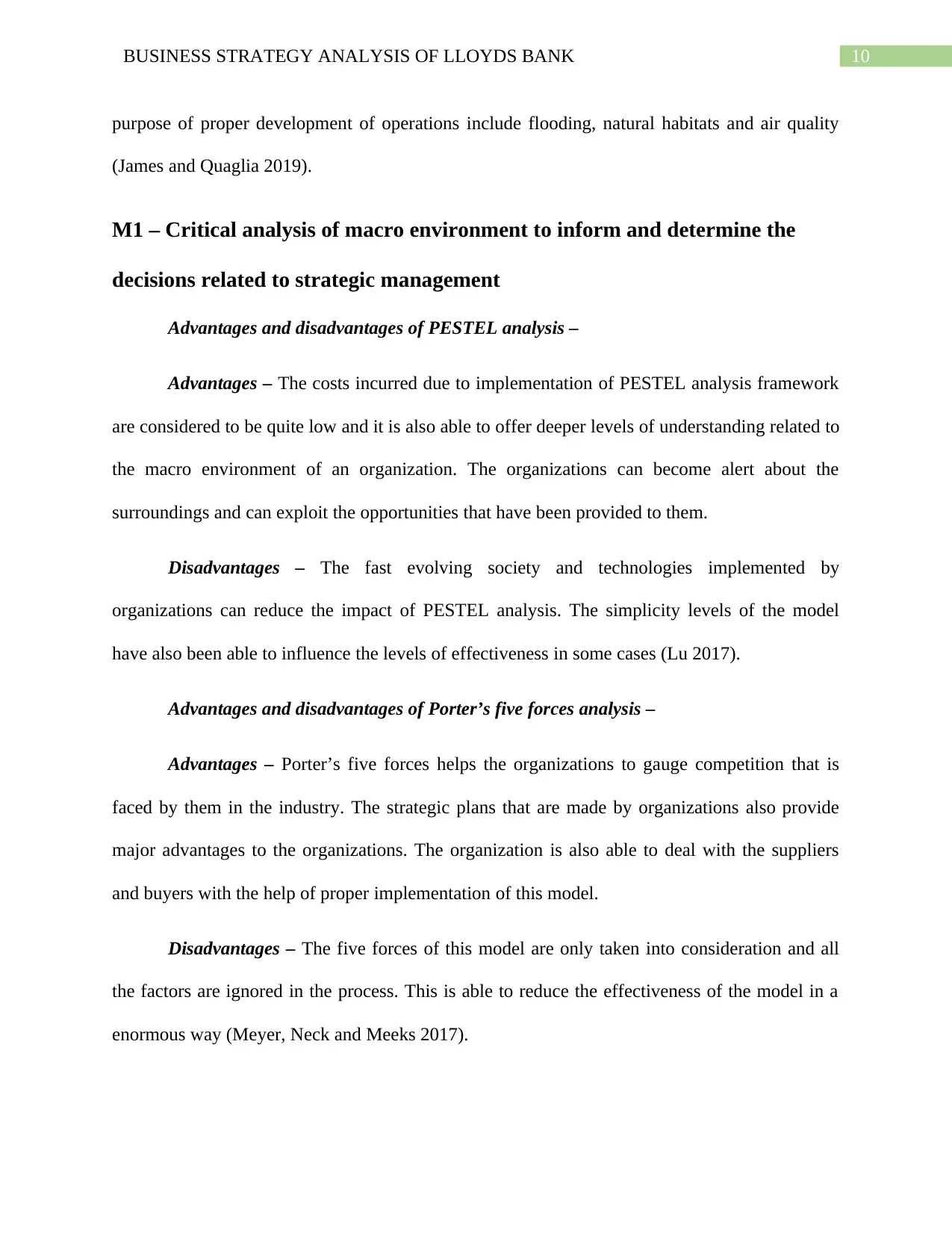
10BUSINESS STRATEGY ANALYSIS OF LLOYDS BANK
purpose of proper development of operations include flooding, natural habitats and air quality
(James and Quaglia 2019).
M1 – Critical analysis of macro environment to inform and determine the
decisions related to strategic management
Advantages and disadvantages of PESTEL analysis –
Advantages – The costs incurred due to implementation of PESTEL analysis framework
are considered to be quite low and it is also able to offer deeper levels of understanding related to
the macro environment of an organization. The organizations can become alert about the
surroundings and can exploit the opportunities that have been provided to them.
Disadvantages – The fast evolving society and technologies implemented by
organizations can reduce the impact of PESTEL analysis. The simplicity levels of the model
have also been able to influence the levels of effectiveness in some cases (Lu 2017).
Advantages and disadvantages of Porter’s five forces analysis –
Advantages – Porter’s five forces helps the organizations to gauge competition that is
faced by them in the industry. The strategic plans that are made by organizations also provide
major advantages to the organizations. The organization is also able to deal with the suppliers
and buyers with the help of proper implementation of this model.
Disadvantages – The five forces of this model are only taken into consideration and all
the factors are ignored in the process. This is able to reduce the effectiveness of the model in a
enormous way (Meyer, Neck and Meeks 2017).
purpose of proper development of operations include flooding, natural habitats and air quality
(James and Quaglia 2019).
M1 – Critical analysis of macro environment to inform and determine the
decisions related to strategic management
Advantages and disadvantages of PESTEL analysis –
Advantages – The costs incurred due to implementation of PESTEL analysis framework
are considered to be quite low and it is also able to offer deeper levels of understanding related to
the macro environment of an organization. The organizations can become alert about the
surroundings and can exploit the opportunities that have been provided to them.
Disadvantages – The fast evolving society and technologies implemented by
organizations can reduce the impact of PESTEL analysis. The simplicity levels of the model
have also been able to influence the levels of effectiveness in some cases (Lu 2017).
Advantages and disadvantages of Porter’s five forces analysis –
Advantages – Porter’s five forces helps the organizations to gauge competition that is
faced by them in the industry. The strategic plans that are made by organizations also provide
major advantages to the organizations. The organization is also able to deal with the suppliers
and buyers with the help of proper implementation of this model.
Disadvantages – The five forces of this model are only taken into consideration and all
the factors are ignored in the process. This is able to reduce the effectiveness of the model in a
enormous way (Meyer, Neck and Meeks 2017).
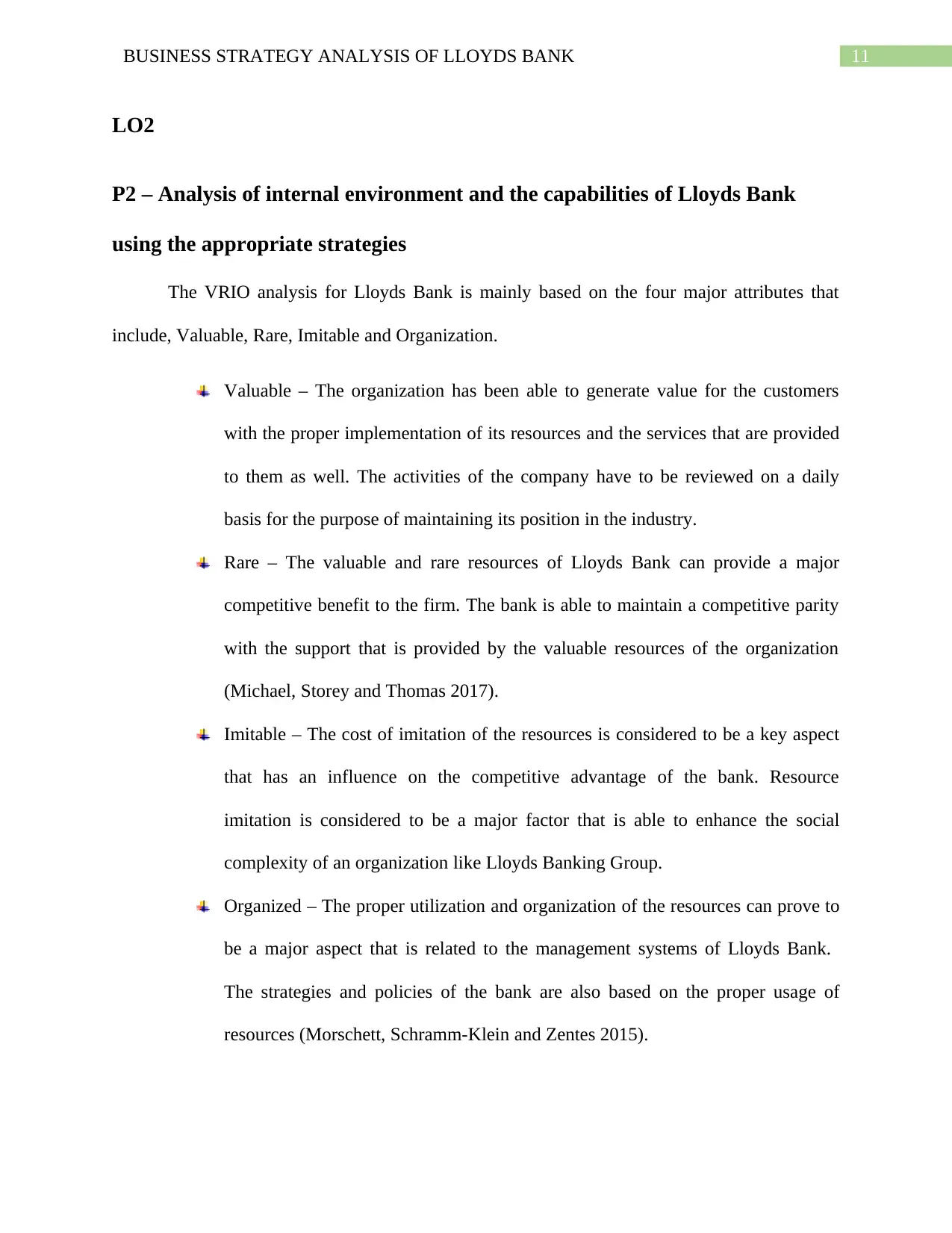
11BUSINESS STRATEGY ANALYSIS OF LLOYDS BANK
LO2
P2 – Analysis of internal environment and the capabilities of Lloyds Bank
using the appropriate strategies
The VRIO analysis for Lloyds Bank is mainly based on the four major attributes that
include, Valuable, Rare, Imitable and Organization.
Valuable – The organization has been able to generate value for the customers
with the proper implementation of its resources and the services that are provided
to them as well. The activities of the company have to be reviewed on a daily
basis for the purpose of maintaining its position in the industry.
Rare – The valuable and rare resources of Lloyds Bank can provide a major
competitive benefit to the firm. The bank is able to maintain a competitive parity
with the support that is provided by the valuable resources of the organization
(Michael, Storey and Thomas 2017).
Imitable – The cost of imitation of the resources is considered to be a key aspect
that has an influence on the competitive advantage of the bank. Resource
imitation is considered to be a major factor that is able to enhance the social
complexity of an organization like Lloyds Banking Group.
Organized – The proper utilization and organization of the resources can prove to
be a major aspect that is related to the management systems of Lloyds Bank.
The strategies and policies of the bank are also based on the proper usage of
resources (Morschett, Schramm-Klein and Zentes 2015).
LO2
P2 – Analysis of internal environment and the capabilities of Lloyds Bank
using the appropriate strategies
The VRIO analysis for Lloyds Bank is mainly based on the four major attributes that
include, Valuable, Rare, Imitable and Organization.
Valuable – The organization has been able to generate value for the customers
with the proper implementation of its resources and the services that are provided
to them as well. The activities of the company have to be reviewed on a daily
basis for the purpose of maintaining its position in the industry.
Rare – The valuable and rare resources of Lloyds Bank can provide a major
competitive benefit to the firm. The bank is able to maintain a competitive parity
with the support that is provided by the valuable resources of the organization
(Michael, Storey and Thomas 2017).
Imitable – The cost of imitation of the resources is considered to be a key aspect
that has an influence on the competitive advantage of the bank. Resource
imitation is considered to be a major factor that is able to enhance the social
complexity of an organization like Lloyds Banking Group.
Organized – The proper utilization and organization of the resources can prove to
be a major aspect that is related to the management systems of Lloyds Bank.
The strategies and policies of the bank are also based on the proper usage of
resources (Morschett, Schramm-Klein and Zentes 2015).
⊘ This is a preview!⊘
Do you want full access?
Subscribe today to unlock all pages.

Trusted by 1+ million students worldwide
1 out of 21
Related Documents
Your All-in-One AI-Powered Toolkit for Academic Success.
+13062052269
info@desklib.com
Available 24*7 on WhatsApp / Email
![[object Object]](/_next/static/media/star-bottom.7253800d.svg)
Unlock your academic potential
Copyright © 2020–2025 A2Z Services. All Rights Reserved. Developed and managed by ZUCOL.



